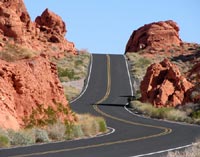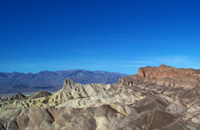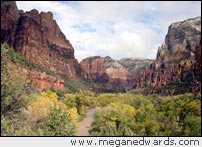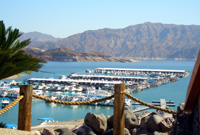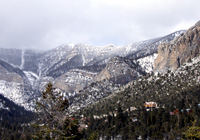Day Trips
Directory of all Day Trips>
Easy One-Day Road Trips from
Las Vegas
by Megan Edwards
[Map]
Yes, Las Vegas is a great destination, and of course there's no reason to leave the Strip once you get there. But if you've got time, wheels and a yen to explore a bit beyond the neon, Las Vegas is also a great starting point for a wide variety of one-day or overnight road trips. Here are six routes that will transport you to the wild wonders surrounding the southern tip of Nevada and still get you back on the Strip in time for dinner and a show.
|
Valley of Fire
Northeast of Las Vegas is Nevada's first state park, Valley of Fire. Named for its flaming red-rock spires, the park is also home to other spectacular rock formations. While it's best to set aside a full day for exploring the park, a road-trip tour from Las Vegas can be completed in four hours. Often used for filming car commercials, Valley of Fire is one of the most photogenic areas in the West. It's impossible to take a bad picture here, but for truly spectacular images, time your trip so that you're in the valley at dawn or sunset. For excellent photos in late afternoon, drive out the short gravel road to Fire Canyon/Silica Dome. Early morning is a great time to grab awesome "road shots" from the
Dining opportunities are scarce on this route, although there is a coffee shop at the Moapa Paiute Travel Plaza at the turnoff for Valley of Fire from Interstate Highway 15. Bring your own food and you can picnic at one of the many scenic picnic areas inside the state park.
Death Valley
Not everyone realizes just how accessible Death
Valley is from Las Vegas. In less than three hours, you
can arrive at Furnace Creek, the major crossroads in Death
Valley National Park. Furnace
Creek offers everything from world-class dining at the
historic Furnace Creek Inn to burgers and snacks at the more
casual Furnace Creek Ranch. From Furnace Creek, a number of
Death Valley's most famous landmarks are minutes away: Zabriskie
Point, Badwater (the lowest spot in North America), Devil's
Golf Course, Artist's Palette, 20-Mule Team Canyon, and Stovepipe
Wells.
The name of the historic Furnace Creek Inn was changed to the
"Inn at Death Valley" and Furnace Creek Ranch is now known as
"The Ranch at Death Valley."
Undeserving of its gloomy name, Death Valley is the
permanent home of hundreds of people, a variety of wildlife
and-when the weather cooperates- glorious displays of springtime
wildflowers. Its colorful history is revealed in displays
at Furnace Creek Ranch and at the National Park Service visitor
center. (Here
is a directory of some of the articles RTA has published about
Death Valley.)
A weekend stay would allow you to explore some of the park's more distant attractions, like the mysterious sliding stones on the Racetrack Playa, but one day is plenty for an auto tour. If you leave Las Vegas early enough in the day, you'll have time to reach the north end of the park, where Park Service docents provide a "living history" tour of the fascinating and well-preserved Scotty's Castle. Before heading up there, top up your gas tank at Furnace Creek. The gas station at Scotty's Castle is currently closed, and the nearest gas station is about an hour away.
Zion National Park
While distance makes Zion National Park a more attractive destination for an overnight or weekend trip, 10 hours is enough to drive there, tour the park by car, and return to Las Vegas. It takes about three hours to reach the park entrance from the city. On the way, food is available in Mesquite, Nev., and in St. George, Utah.
Zion is one of those places that defies easy description. All the appropriate adjectives-"awesome," "spectacular," "magnificent"-sound like exaggerations, but in fact they don't even do it justice. With its tall golden walls, the deep canyon is like an enchanted interior -- something you'd expect to see in a "Lord of the Rings" movie. Light snowcaps make the colorful rocks beautiful in winter, but spring is just as enchanting as all the trees on the forest floor begin to leaf out. Summer offers a full green lushness and cool mountain temperatures, and in fall, the whole valley turns to gold. There is no bad time to visit Zion.
In winter, you can take the scenic route through the canyon in your own vehicle, but from the end of March through the end of October, you must take one of the Park Service's shuttle buses. Either way, you can stop at several or all of the landmarks and viewing points along the route, then return to the park entrance at your leisure. With more time, it's possible to explore other areas of the park and enjoy some of the trails to waterfalls and scenic views. The rustic and inviting Zion Lodge has rooms, cabins and a restaurant.
Red Rock Canyon
By far the closest natural wonder to Las Vegas is Red Rock Canyon , which is a mere 40-minute drive from the Strip. Accessible from Blue Diamond Road on the south side of town and from Charleston Boulevard on the north, the canyon is nestled in the lower slopes of the Spring Mountains. A one-way "scenic loop" through the most picturesque rock formations is like taking a hike without ever leaving your vehicle. Even so, it's worth stopping at some of the parking areas and walking a bit for even better views and a closer look at the flora and fauna in the area. If you're lucky, you might even meet a desert tortoise. If you aren't, you can see one at the visitor center, which has excellent displays about the history, geology and wildlife of the area.
Lake Mead
The enormous expanse of water created by Hoover Dam offers a fascinating shoreline to explore. Half a day is enough to complete a loop tour of the Lake Mead National Recreation Area, but a full day provides opportunity for a closer look at some of the man-made and natural phenomena to be found there. Two warm springs, Rogers and Blue Point, are home to small fish and relict leopard frogs. Marinas dot the edge of the lake, and several have restaurants and motels. You can rent a boat, kayak or canoe, or just sunbathe on a beach. If you're interested in archaeology, the ruins of the town of St. Thomas, which have been exposed by the declining water level in recent years, are fascinating to explore. Popular in summer with swimmers and water-skiers, Lake Mead is a great road-trip destination year-round. In the spring, brilliant wildflower displays make it especially photogenic.
Mount Charleston
Rivaling Red Rock Canyon in proximity to the city, Mount Charleston is a surprise to all those who think of Las Vegas as flat and arid. Rising to nearly 12,000 feet, Mount Charleston offers skiing in the winter, hiking in the summer, and a great road trip all year round. While it's best to avoid it on days with active precipitation unless you like mountain driving in rain or snow, Mount Charleston offers an alpine getaway on a par with California's Sierra Nevadas. The Mt. Charleston Hotel, situated halfway to the top of the road, has a restaurant and bar with views of the valley. At the top, the Mount Charleston Lodge also offers food and drink along with spectacular views of the peaks and canyons. A trip up Mount Charleston and back can be completed in as little as two hours from the city; a little more time will allow for exploring on foot. An easy hike to Cathedral Rock, for example, takes as little as two hours and offers even more lovely views.
What, no Grand Canyon?
As the crow flies, Grand Canyon is indeed quite close to Las Vegas, which is why you'll see all those advertisements for helicopter tours on the Strip. Driving there, however, is another story. A trip to Grand Canyon from Las Vegas cannot be completed in a day, and even an overnight trip is too short. Allow a weekend if you really want to be able to enjoy your visit.
Be safe
Whenever you head out from Las Vegas, remember that you are in a desert. Never, ever travel without water, no matter what season of the year it is. If you're staying in a hotel, stop at a convenience store and buy a six-pack of bottled water per person. For more tips on outfitting a car for a desert road trip, consider this advice from the Great American RoadTrip Forum.
Megan Edwards
2/15/08
(Updated 8/12/20, RTA)

